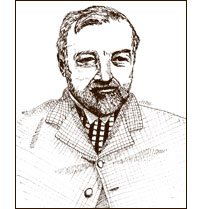Inventor Samuel Pierpont Langley
 Born in the Boston suburb of Roxbury, Ma., Samuel Langley was one of America's most accomplished scientists. His work as an astronomy, physics, and aeronautics pioneer was highly regarded by the international science community. Ironically though, Langley's formal education ended at the high school level, but he managed to continue his scientific education in Boston's numerous libraries. Langley began his career as a civil engineer in Chicago, continuing later in St. Louis, before returning to Boston to accept an assistantship at the Harvard Observatory. Heading south once again, Langley later taught mathematics at the U.S. Naval Academy in Annapolis, Md. Then, from 1867-87, he served as professor of physics and astronomy as well as director of the Allegheny Observatory at the Western University of Pennsylvania (now known as the University of Pittsburgh). After 1887, Langley was appointed Secretary of the Smithsonian Institution in Washington D.C.
Born in the Boston suburb of Roxbury, Ma., Samuel Langley was one of America's most accomplished scientists. His work as an astronomy, physics, and aeronautics pioneer was highly regarded by the international science community. Ironically though, Langley's formal education ended at the high school level, but he managed to continue his scientific education in Boston's numerous libraries. Langley began his career as a civil engineer in Chicago, continuing later in St. Louis, before returning to Boston to accept an assistantship at the Harvard Observatory. Heading south once again, Langley later taught mathematics at the U.S. Naval Academy in Annapolis, Md. Then, from 1867-87, he served as professor of physics and astronomy as well as director of the Allegheny Observatory at the Western University of Pennsylvania (now known as the University of Pittsburgh). After 1887, Langley was appointed Secretary of the Smithsonian Institution in Washington D.C.
Langley's chief scientific interest was the sun and its effect on the weather, and believed that all life and activity on the Earth were made possible by the sun's radiation. In 1878 he invented the bolometer, a radiant-heat detector that is sensitive to differences in temperature of one hundred-thousandth of a degree Celsius. Composed of two thin strips of metal, a Wheatstone bridge, a battery, and a galvanometer, this instrument enabled him to study solar irradiance far into its infrared region and to measure the intensity of solar radiation at various wavelengths. Bolometers have been flown on numerous NASA missions including the Earth's Radiation Budget Experimentand the Clouds and Earth's Radiant Energy System, which provided accurate regional and global measurements of the components of the Earth's radiation budget. Langley's highly original and innovative research earned him honorary doctorates, awards, and medals from universities and scientific societies around the world.
In addition to his solar interests, Langley was the only professional scientist of his day who believed that man was destined to fly. While at the Allegheny Observatory, he made important experiments on the lift and drag of an aircraft moving through the air at a measured speed. Backed by these experiments, he was the first to offer a clear explanation of the way birds soar and glide without appreciable wing movement. Langley's memory lives on in the names of the NASA Langley Research Center, the adjacent Air Force base, and several place names across the country. Our nation's first aircraft carrier, CV-1, built at the Norfolk Navy Yard in the early 1920's, was also named after Langley.
About the Author
NASA NASA Earth Observatory
 NASA Earth Observatory is an online publishing outlet for NASA which was created in 1999. It is the principal source of satellite imagery and other scientific information pertaining to the climate and the environment which are being provided by NASA for consumption by the general public.
NASA Earth Observatory is an online publishing outlet for NASA which was created in 1999. It is the principal source of satellite imagery and other scientific information pertaining to the climate and the environment which are being provided by NASA for consumption by the general public.


